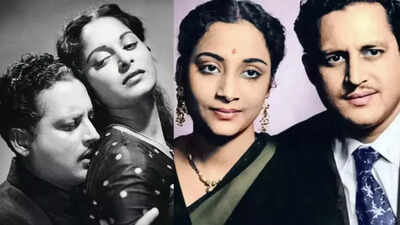Guru Dutt, born as Vasanth Kumar Shivashankar Padukone, remains one of Indian cinema’s most iconic and visionary filmmakers. Known for his innovative storytelling and visual brilliance, Dutt’s films often carried a melancholic undertone, echoing the turbulence of his own life. His journey in cinema began in 1944 as a choreographer, but it was his directorial prowess that set him apart as a true maverick. He went on to make some of the best movies of Hindi cinema which will be remembered for generations to come, like ‘Pyaasa’, ‘Kaagaz Ke Phool’, ‘Sahib Bibi Aur Ghulam’, among others While his professional achievements were unmatched, Guru Dutt’s personal life was fraught with emotional turmoil. In 1953, he married the celebrated playback singer Geeta Roy, whose soulful voice had captured his heart during the making of Baazi. Their love blossomed despite strong opposition from Geeta’s family, who were concerned about her being the family’s sole provider. The couple remained undeterred and tied the knot on May 26, 1953, eventually having three children – Tarun, Arun, and Nina.
However, cracks in their marriage soon began to show. Dutt’s in-laws believed he had married Geeta for financial reasons, prompting him to restrict her from singing for films outside his own productions. Geeta’s affection gradually gave way to jealousy and suspicion, particularly concerning Guru Dutt’s interactions with his female co-stars. Guru Dutt’s sister, Lalitha Lajmi, once revealed, “They had 11 years of a tempestuous marriage. Both of them were brilliant as artistes but as a couple faced constant friction. She was suspicious of every actress he worked with. She kept tabs on him all the time. That was her only undoing. There would be frequent quarrels and she’d take the children away to her mother’s home. He’d beg her to return.” One such actress was Waheeda Rehman. Dutt cast her in her breakout lead role in Pyaasa, which later became one of the most revered films in Indian cinema. Their on-screen collaboration blossomed into a deeply personal bond. They worked together on several acclaimed films such as ‘12 O’Clock’, ‘Kaagaz Ke Phool’, and ‘Chaudhvin Ka Chand’. While Waheeda saw him as her mentor, their growing closeness became a source of strain in his already fragile marriage. Speculations abounded about their relationship, some viewed Waheeda as his muse, and others believed he had fallen hopelessly in love with her, which many saw as the final blow to his crumbling marriage with Geeta. In ‘Ten Years with Guru Dutt: Abrar Alvi’s Journey’, by Sathya Saran, Abrar recalled how Mumtaz Begum (Waheeda’s mother) was worried about the future of their relationship. “‘Abrar, what will happen to my daughter? I worry about her’. Her fears were well-founded. ‘My daughter is not the type to flit from man to man, and he is a married man,’ she would say to me. ‘She tells me that he says he will give up his life for her.’ She knew I was close to Guru Dutt and probably hoped I would ask him about his intention.” However, Rahman also never spoke about her relationship with Guru Dutt. In a chat with Nasreen Munni Kabir for her book Conversations with Waheeda Rehman, here’s what she had said when asked about rumours of their relationship. “His work came first, then his wife and children. He was obsessed with filmmaking. None of my film colleagues have ever asked me personal questions about our relationship. It was always other people and the press who was curious, and still is, almost sixty years later. I know we are public figures but I strongly believe my private life should remain private. What ultimately matters and concerns the world is the work we leave behind.” As personal tensions mounted, Guru Dutt’s emotional and mental health deteriorated. Struggling with financial troubles and the breakdown of his personal relationships, he turned to alcohol. Over time, even Waheeda distanced herself from him, reportedly due to his increasing dependence on alcohol and his frequent bouts of anxiety and depression. On the night of October 10, 1964, Guru Dutt’s life came to a tragic end. He consumed a combination of alcohol and sleeping pills, leading to what many believe was an accidental overdose, though some continue to view it as a deliberate act of despair.

